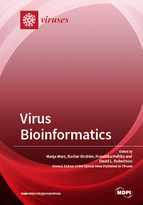Virus Bioinformatics
A special issue of Viruses (ISSN 1999-4915).
Deadline for manuscript submissions: closed (31 March 2019) | Viewed by 108669
Special Issue Editors
Interests: high throughput sequencing analysis; bioinformatic analysis and system biology of viruses; comparative genomics; identification and annotation of non-coding RNAs; coevolution of proteins and RNAs; algorithmic bioinformatics
Special Issues, Collections and Topics in MDPI journals
2. Institute of Bioinformatics, Friedrich Schiller University Jena, Jena, Germany
3. The European Virus Bioinformatics Center, Jena, Germany
Interests: mathematical and computational systems biology; multiscale and unconventional modelling, simulation, and analysis of complex systems
Special Issues, Collections and Topics in MDPI journals
Interests: computational metabolomics and mass spectrometry; algorithms in bioinformatics; virus bioinformatics
Special Issues, Collections and Topics in MDPI journals
Special Issue Information
Dear Colleagues,
This Special Issue is related to the Third Annual Meeting of the European Virus Bioinformatics Center which will be held at the University of Glasgow, Glasgow, UK, in March, 2019.
Bioinformatics is focusing on bacteria and eukaryotic model organisms while virologists have an urgent need of virus-specific bioinformatical tools. Apart from pioneering work on HIV-1, HCV and influenza, these two communities have interacted surprisingly sporadically.
This special issue will present articles covering computational approaches in virology, and we welcome any contributions within this cross-disciplinary field. Sub-topics include (but are not limited to): Virus detection, annotation, and comparison; quasispecies, phylogeny, and cophylogeny; virus–host interaction and replication; as well as drug design. We aim with this Special Issue for excellence and innovation with deep impact for a better, healthy world.
Hence, the Special Issue is open to all researchers working on the boundaries between bioinformatics and virology.
Papers are welcome as original research articles, as well as review papers dealing with recent advancements and current understanding of computational technologies aspects of virology.
All papers should be submitted online at https://www.mdpi.com/journal/viruses. Please select the correct Special Issue when submitting your paper to Viruses.
Prof. Dr. Manja Marz
PD Dr. habil. Bashar Ibrahim
Dr. Franziska Hufsky
Prof. Dr. David L. Robertson
Guest Editors
Manuscript Submission Information
Manuscripts should be submitted online at www.mdpi.com by registering and logging in to this website. Once you are registered, click here to go to the submission form. Manuscripts can be submitted until the deadline. All submissions that pass pre-check are peer-reviewed. Accepted papers will be published continuously in the journal (as soon as accepted) and will be listed together on the special issue website. Research articles, review articles as well as short communications are invited. For planned papers, a title and short abstract (about 100 words) can be sent to the Editorial Office for announcement on this website.
Submitted manuscripts should not have been published previously, nor be under consideration for publication elsewhere (except conference proceedings papers). All manuscripts are thoroughly refereed through a single-blind peer-review process. A guide for authors and other relevant information for submission of manuscripts is available on the Instructions for Authors page. Viruses is an international peer-reviewed open access monthly journal published by MDPI.
Please visit the Instructions for Authors page before submitting a manuscript. The Article Processing Charge (APC) for publication in this open access journal is 2600 CHF (Swiss Francs). Submitted papers should be well formatted and use good English. Authors may use MDPI's English editing service prior to publication or during author revisions.
Keywords
- specific bioinformatical tools to be applied in virology
- computational modeling for viruses
- virus detection, annotation, and comparison
- quasispecies, phylogeny, and cophylogeny
- virus-host interaction and replication
- drug design
Related Special Issues
- Virus Bioinformatics 2020 in Viruses (15 articles)
- Virus Bioinformatics 2022 in Viruses (12 articles)
- Virus Bioinformatics 2023 in Viruses (11 articles)
- Virus Bioinformatics 2024 in Viruses








